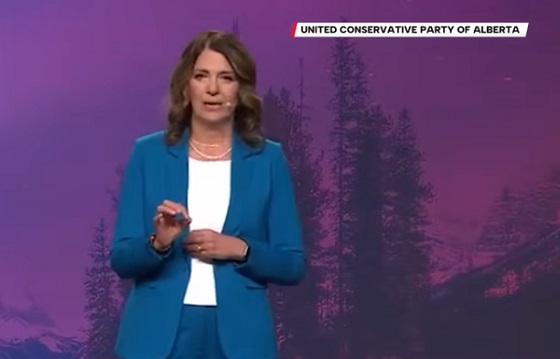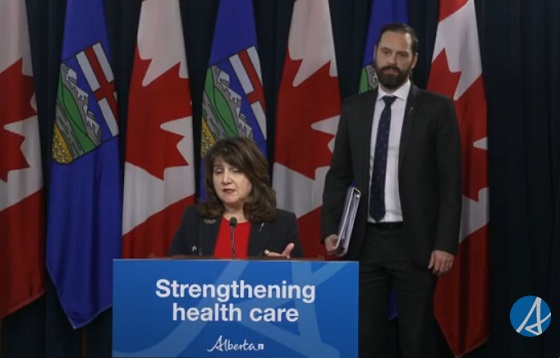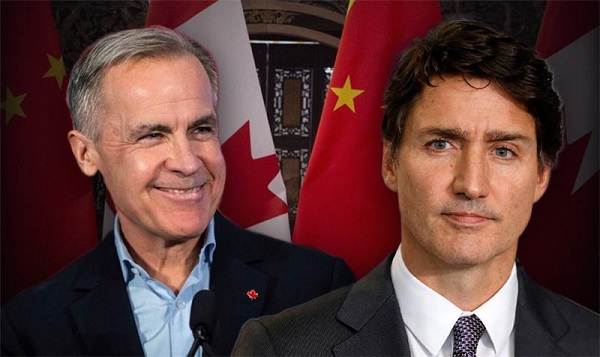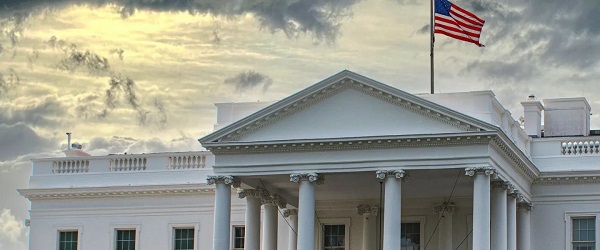Alberta
Province completely revamps funding for K-12 education – Adriana LaGrange announcement

From the Province of Alberta
Transforming K-12 education funding
A new way to fund Alberta’s K-12 education system will drive more dollars to the classroom where they can deliver the best outcomes for students.
The new model streamlines operations and directs more dollars to each school division. In the 2020-21 school year, every single division will see an increase in operational funding.
The model also provides more predictability in funding by changing from one-year enrolment counts to a moving three-year average, minimizing the need for mid-year adjustments to school budgets. The move will help school divisions plan their finances well in advance of the start of the school year.
“Alberta will continue to have one of the best-funded education systems in the country. This new model will drive more money to our school divisions for use in the classroom and provides them with the flexibility they need to meet the unique needs of their students. These changes will ensure our divisions continue to be equipped to provide our students with a world-class, high quality education.”
The new model also reduces red tape and gives more flexibility to school divisions to determine how to best invest taxpayer dollars. By simplifying the number of grants to 15 from the current 36, while still maintaining education funding, school divisions will have reduced reporting obligations and more leeway to direct funding to support the needs of students.
“This government is committed to cutting unnecessary red tape by one-third to reduce costs, speed up approvals and make life better for Albertans. I am thrilled that we are updating and streamlining the K-12 funding model, while maintaining robust measures to ensure money is being directed to the classroom. School boards can now spend less time on unnecessary reporting and administration work and more time focusing on students.”
Highlights of the new model include:
- Ensuring funds are directed to classrooms by providing a targeted grant for system administration, instead of a percentage of overall funding. This will standardize administrative and governance spending to within a reasonable range and maximize dollars intended for classrooms. The new model will also simplify grants to reduce red-tape for school authorities.
- Protecting our most vulnerable students by providing funding intended to support specialized learning needs or groups of students who may require additional supports from school authorities, including Program Unit Funding, funding for English as a Second Language students, French as a Second Language students, refugee students and First Nations, Métis and Inuit students.
- Better managing system growth, specifically enrolment growth and associated costs. Instead of funding based on a student count each year calculated in the fall, the new model will adopt a weighted, moving three-year average when calculating enrolment for funding. Using a weighted moving average means school boards will no longer have to wait until they have a confirmed number of students — typically at the end of September when the school year is already underway — to determine how much funding they will have for the year. This should minimize school authorities having to adjust their revenue forecasts and/or staffing levels throughout the school year.
- Providing funding predictability for school authorities by confirming their funding commitments from the province by the end of March each year, instead of the end of September when the school year has already begun. This will minimize the need for mid-year adjustments to budgets and staffing, create better alignment between the school year and the government’s fiscal year, and provide boards with more predictability in their planning and budgeting processes. A move to a block-funding model for small rural schools will also ensure the long-term viability of these schools where per-student funding does not provide adequate resources to properly deliver programs and services.
- Enhancing system accountability for school jurisdictions. The new model will include new accountability measures keeping school boards accountable for student outcomes, community engagement and continuous improvement.
“Our new funding model gives schools more of what they want – flexibility, stability and predictability. Flexibility to invest provincial dollars in areas that make the most sense for their communities. Stability in the number of grants and what the province expects for reporting. And predictability in their funding envelope to allow for better planning well ahead of each school year.”
The funding model for K-12 education has not changed in more than 15 years. The province met with each public, separate and Francophone school division, along with other system partners, in the fall of 2019 to discuss improvements to the way funding flows to school divisions. Overall, divisions wanted more predictability in their funding so they could better plan for each school year, more flexibility in how they spend provincial dollars based on their own needs in their communities, and reductions in provincial red tape.
Specific details for each grant and each school division’s funding will be available in Budget 2020, and will take effect for the 2020-21 school year.
“The College of Alberta School Superintendents recognizes the significant efforts Minister LaGrange has taken to engage with individual school authorities, the CASS Board and other education partners in the development of this new funding framework. The Minister’s willingness to listen and incorporate this feedback is clear as the new funding framework reflects a return to increased autonomy for local board decision making coupled with a reduction in the red tape school authorities have been challenged with in recent years. Finally, while we certainly recognize the fiscal challenges our province is currently experiencing, we are gratified to hear the Minister’s commitment in this budget to an increase in overall projected budget for every Alberta school authority over the previous year’s funding.”
“We appreciate that the government considered input from the education system as they developed the new funding model. This new model will reduce some of the red tape associated with accessing certain grants. It will also give school boards the ability to better predict the amount of funding they will receive in future years within the new, simplified model.”
“Alberta School Boards Association (ASBA) is pleased that government consulted with us on the new assurance and funding framework. We appreciate that government has released the funding framework, as ASBA requested, in advance of the budget. This allows boards time to review and understand the implications within the context of their local realities. ASBA will work closely with school boards and government to support implementation upon release of the budget.”
“We appreciate that Minister LaGrange has listened to our concerns and demonstrated her confidence and trust in the local autonomy of school boards to make decisions that are in the best interests of their students. While this is a complex matter that will take time for us to determine the impact on the classroom, we are optimistic that these changes will bring opportunity for our district. The reduction of red tape afforded by the new model will help reduce the complexity and workload involved in providing extensive and repetitious data, which in turn, will allow our teachers to focus on what is most important — our students.”
“Allowing important education funding decisions at a local level is a great step forward for parents’ choice in education and the ability of local school divisions — working with parents — to ensure key priorities are met. This new funding model will provide flexibility on how school divisions provide a precise and quality education to meet the needs of the students and the communities they serve.”
“We are pleased to see that Minister LaGrange has been responsive to our concerns for less red tape as well as targeted supports for small rural schools. We are also pleased to see her continued support for local board autonomy and the flexibility for our board to manage those decisions that most impact our students. We look forward to the release of the full budget details and are hopeful, even in difficult economic times, this new framework will continue to support our board as we provide high quality public education to our students.“
“We are pleased to see the government trust locally elected boards to make the right decisions for their students by providing us flexibility within our funding envelopes. The increased flexibility afforded by this new funding model will help us better allocate resources to address the unique needs of our students, while also cutting down on the significant red tape that was tied to the previous funding structure. We are looking forward to working with the government as this model rolls out for the 2020-21 school year.”
Alberta
Keynote address of Premier Danielle Smith at 2025 UCP AGM

Alberta
Net Zero goal is a fundamental flaw in the Ottawa-Alberta MOU

From the Fraser Institute
By Jason Clemens and Elmira Aliakbari
The challenge of GHG emissions in 2050 is not in the industrial world but rather in the developing world, where there is still significant basic energy consumption using timber and biomass.
The new Memorandum of Understanding (MOU) between the federal and Alberta governments lays the groundwork for substantial energy projects and infrastructure development over the next two-and-a-half decades. It is by all accounts a step forward, though, there’s debate about how large and meaningful that step actually is. There is, however, a fundamental flaw in the foundation of the agreement: it’s commitment to net zero in Canada by 2050.
The first point of agreement in the MOU on the first page of text states: “Canada and Alberta remain committed to achieving net zero greenhouse gas emissions by 2050.” In practice, it’s incredibly difficult to offset emissions with tree planting or other projects that reduce “net” emissions, so the effect of committing to “net zero” by 2050 means that both governments agree that Canada should produce very close to zero actual greenhouse gas (GHG) emissions. Consider the massive changes in energy production, home heating, transportation and agriculture that would be needed to achieve this goal.
So, what’s wrong with Canada’s net zero 2050 and the larger United Nations’ global goal for the same?
Let’s first understand the global context of GHG reductions based on a recent study by internationally-recognized scholar Vaclav Smil. Two key insights from the study. First, despite trillions being spent plus international agreements and regulatory measures starting back in 1997 with the original Kyoto agreement, global fossil fuel consumption between then and 2023 increased by 55 per cent.
Second, fossil fuels as a share of total global energy declined from 86 per cent in 1997 to 82 per cent in 2022, again, despite trillions of dollars in spending plus regulatory requirements to force a transition away from fossil fuels to zero emission energies. The idea that globally we can achieve zero emissions over the next two-and-a-half decades is pure fantasy. Even if there is an historic technological breakthrough, it will take decades to actually transition to a new energy source(s).
Let’s now understand the Canada-specific context. A recent study examined all the measures introduced over the last decade as part of the national plan to reduce emissions to achieve net zero by 2050. The study concluded that significant economic costs would be imposed on Canadians by these measures: inflation-adjusted GDP would be 7 per cent lower, income per worker would be more than $8,000 lower and approximately 250,000 jobs would be lost. Moreover, these costs would not get Canada to net zero. The study concluded that only 70 per cent of the net zero emissions goal would be achieved despite these significant costs, which means even greater costs would be imposed on Canadians to fully achieve net zero.
It’s important to return to a global picture to fully understand why net zero makes no sense for Canada within a worldwide context. Using projections from the International Energy Agency (IEA) in its latest World Energy Outlook, the current expectation is that in 2050, advanced countries including Canada and the other G7 countries will represent less than 25 per cent of global emissions. The developing world, which includes China, India, the entirety of Africa and much of South America, is estimated to represent at least 70 per cent of global emissions in 2050.
Simply put, the challenge of GHG emissions in 2050 is not in the industrial world but rather in the developing world, where there is still significant basic energy consumption using timber and biomass. A globally-coordinated effort, which is really what the U.N. should be doing rather than fantasizing about net zero, would see industrial countries like Canada that are capable of increasing their energy production exporting more to these developing countries so that high-emitting energy sources are replaced by lower-emitting energy sources. This would actually reduce global GHGs while simultaneously stimulating economic growth.
Consider a recent study that calculated the implications of doubling natural gas production in Canada and exporting it to China to replace coal-fired power. The conclusion was that there would be a massive reduction in global GHGs equivalent to almost 90 per cent of Canada’s total annual emissions. In these types of substitution arrangements, the GHGs would increase in energy-producing countries like Canada but global GHGs would be reduced, which is the ultimate goal of not only the U.N. but also the Carney and Smith governments as per the MOU.
Finally, the agreement ignores a basic law of economics. The first lesson in the very first class of any economics program is that resources are limited. At any given point in time, we only have so much labour, raw materials, time, etc. In other words, when we choose to do one project, the real cost is foregoing the other projects that could have been undertaken. Economics is mostly about trying to understand how to maximize the use of limited resources.
The MOU requires massive, literally hundreds of billions of dollars to be used to create nuclear power, other zero-emitting power sources and transmission systems all in the name of being able to produce low or even zero-emitting oil and gas while also moving to towards net zero.
These resources cannot be used for other purposes and it’s impossible to imagine what alternative companies or industries would have been invested in. What we do know is that workers, entrepreneurs, businessowners and investors are not making these decisions. Rather, politicians and bureaucrats in Ottawa and Edmonton are making these decisions but they won’t pay any price if they’re wrong. Canadians pay the price. Just consider the financial fiasco unfolding now with Ottawa, Ontario and Quebec’s subsidies (i.e. corporate welfare) for electric vehicle batteries.
Understanding the fundamentally flawed commitment to Canadian net zero rather than understanding a larger global context of GHG emissions lays at the heart of the recent MOU and unfortunately for Canadians will continue to guide flawed and expensive policies. Until we get the net zero policies right, we’re going to continue to spend enormous resources on projects with limited returns, costing all Canadians.
-

 Alberta2 days ago
Alberta2 days agoAlberta can’t fix its deficits with oil money: Lennie Kaplan
-

 International2 days ago
International2 days agoTrump vows to pause migration after D.C. shooting
-

 Daily Caller2 days ago
Daily Caller2 days ago‘No Critical Thinking’: Parents Sound Alarm As Tech Begins To ‘Replace The Teacher’
-

 Business2 days ago
Business2 days agoCanadians love Nordic-style social programs as long as someone else pays for them
-

 Food7 hours ago
Food7 hours agoCanada Still Serves Up Food Dyes The FDA Has Banned
-

 National1 day ago
National1 day agoAlleged Liberal vote-buying scandal lays bare election vulnerabilities Canada refuses to fix
-

 Addictions1 day ago
Addictions1 day agoThe Death We Manage, the Life We Forget
-

 National17 hours ago
National17 hours agoEco-radical Canadian Cabinet minister resigns after oil deal approved











